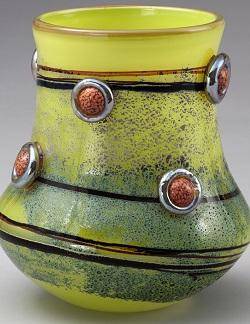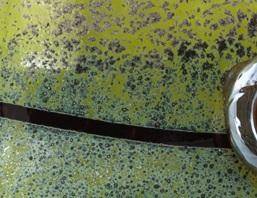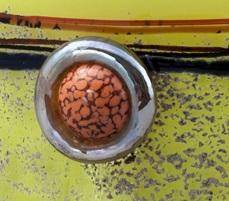Help your students develop their basic art vocabulary starting with terms often used to describe the features of a jar or vase. Next, encourage students to run wild with descriptive adjectives as they write about Tony Jojola’s glass jar.
Students will be able to:
- Identify the features of a jar or vase and use appropriate terms;
- Understand the source of an artist’s inspiration; and
- Use expressive language to describe a piece of artwork
Lesson
- Warm-up: Display the image of Untitled (Kilt Series O6) and invite students to look carefully and share what they observe. Ask: What do you notice? What colors do you see? What material do you think the artist used to make this? What words would you use to describe this piece? How would you label the different parts of this jar? How would you describe its shape? What do you think is most interesting about this piece?
- Share with students that this piece was created by an artist named Tony Jojola who grew up in the Isleta Pueblo in New Mexico and watched his father and grandfather work as silversmiths and his grandmother work as a potter. While the piece is in the shape of a traditional Isleta jar, it is not made of clay; rather it’s made of glass accented with speckled red beads and silver dust. The bright colors are a trademark of Jojola’s work. He says “I love color, I love Van Gogh, but those paintings are not what inspired me. The colors I love are the ones we have in the world of New Mexico.”
- Introduce students to the words artists and museum experts use to describe a jar or vase. Start with a simple outline of a vase on the board. At the top of the vase, label the “mouth” which is the opening at the top. Next, label the “neck” which is (usually, but not always) the narrower part that leads from the body to the mouth of the vase. Label the main part of the vase the “body” and label the base of the vase the “foot.” Explain that when people describe how a vase or a jar looks they use these terms to help their reader understand which part of the piece they’re describing. So let’s use these terms too!
- Have students fold their piece of paper in half lengthwise and crease and then in half again and crease. Next, open the piece or paper up and fold it in half width-wise and crease. After unfolding the piece of paper, the students should have each created a sheet with 8 equal boxes defined by creases. Show the students how to write the following 8 headers, one at the top of each box: “body color,” “decoration,” “material,” “mouth,” “neck,” “body,” “foot” and “extreme adjectives.”
- Ask students to consider the following scenario: What if you were in charge of buying new pieces of art for a famous museum and you had just seen Untitled (Kilt Series 06) in an art gallery in New Mexico. You really liked it and felt the museum should add it to their collection, but you needed to first get approval from your boss before buying it. Unfortunately, there’s no way to send photos of the jar to your boss, so you’ll have to describe it over the phone using as much detail as possible, plus some extremely positive adjectives to describe how beautiful this piece of artwork is. What would you say to your boss to make him agree to buy the glass jar for the museum? Using as interesting and as descriptive language as possible, ask students to write about each of these aspects of Tony Jajola’s artwork in the boxes on their paper. For example, a student might write “the body color is a lively lime green like the color of young leaves when they first pop out of a branch in springtime.” For the mouth of the jar, a student might write “it’s big and circular and about the same size as the foot of the jar.” For the neck of the jar, a student might write “the neck is straight from the mouth to the body.” In terms of extreme adjectives, a student might write “gorgeous, unique, stellar, inspired, radiant!”
- Once students have filled their papers with descriptive detail, regroup and ask students to share some of what they wrote. Do they think the boss would have agreed to the purchase?
Materials
- Large piece of chart paper and markers or (interactive) whiteboard on which to record students’ ideas as a class
- 1 sheet of paper per student and pencils
- About the Art section on Untitled (Kilt Series 06) by Tony Jojola (included with the lesson plan) or student access to this part of Creativity Resource online
- One color copy of the artwork for every four students, or the ability to project the image onto a wall or screen
Standards
- Visual Arts
- Observe and Learn to Comprehend
- Relate and Connect to Transfer
- Language Arts
- Oral Expression and Listening
- Writing and Composition
- Critical Thinking & Reasoning
- Information Literacy
- Invention
- Self-Direction
Untitled (Kilt Series 06)
- Tony Jojola, Isleta, American, 1958-2022
- Born: New Mexico
- Work Locations: Isleta pueblo
Tony Jojola (Ho-ho-la) is one of the most innovative glass artists in the United States. He was born in Isleta Pueblo in New Mexico in 1958 and grew up surrounded by artists. His grandfather and father were silversmiths and his grandmother was a potter. Jojola first learned glassblowing techniques at the Institute of American Indian Arts in Santa Fe, and then studied with internationally renowned glass artist Dale Chihuly at Pilchuck Glass School. After achieving career success, Jojola founded the Taos Glass Arts and Education program, which teaches young people how to express themselves in glass.
As more Pueblo artists learn to work in glass, the question of what is “traditional” comes up. Jojola looks at it this way: “Lots of people think silver is a traditional Native American medium, but it wasn’t in the beginning.”
Jojola’s family and cultural background have significantly influenced his work. He learned pottery making from his grandmother and continues to shape traditional forms, using glass instead of clay. “I feel that glass relates to clay very strongly,” he says. “To me, glass is like clay you can’t touch.” Jojola also honors his family by using his grandfather’s silver jewelry stamps on some of his glass vessels.
Jojola's time at the Pilchuck Glass School and exposure to artists like Vincent van Gogh also play a pivotal role in the work he creates. “I continue to rely on my culture for inspiration, but I want to be known as a contemporary artist, an innovator,” Jojola says.
Details

Shape
The shape of Untitled (Kilt Series 06) is reminiscent of the form of traditional Isleta Pueblo jars, such as the one shown in this image here.

Color
Jojola is known for his use of bright, distinctive colors, like this lime green with accents of red and black. “I love color, I love Van Gogh, but those paintings are not what inspired me. The colors I love are the ones we have in the world of New Mexico,” he says.

Red and Black Lines
Working from drawings, Jojola applies colored threads of glass with a hot torch while an assistant holds the piece steady. Jojola employs several skilled assistants because the glassblowing process requires him to move quickly and leaves little room for error.

Sparkly Surface
Jojola rolls or dips the glass in silver dust to create a sparkly surface.

The Red Beads
Jojola used Hubbell beads, originally sold at the Hubbell Trading Post in the late 1880s and 1890s, to embellish this vessel. The owner and founder of the trading post most likely bought the beads from Czech beadmakers and resold them to American Indian artists. We can assume that Jojola bought or collected these beads to use in his art.
Funding for object education resources provided by a grant from the Morgridge Family Foundation. Additional funding provided by the William Randolph Hearst Endowment for Education Programs, and Xcel Energy Foundation. We thank our colleagues at the University of Denver Morgridge College of Education.
The images on this page are intended for classroom use only and may not be reproduced for other reasons without the permission of the Denver Art Museum. This object may not currently be on display at the museum.







